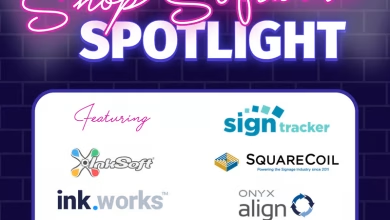 This month’s interview is with Judy Heft. She is a longtime member of the digital graphics community and is currently the Product Team Manager at Nazdar SourceOne. Recently relocated to Kansas City, Judy enjoys exploring outdoor adventures with her daughter and dog around her new home, as well as globally.
This month’s interview is with Judy Heft. She is a longtime member of the digital graphics community and is currently the Product Team Manager at Nazdar SourceOne. Recently relocated to Kansas City, Judy enjoys exploring outdoor adventures with her daughter and dog around her new home, as well as globally.
- What path led you to your current role with Nazdar SourceOne?
My career has evolved through almost every aspect of the graphics market: designer, sign production, shop management, regional value-add reseller, industry manufacturer, and national value-add reseller. Throughout my career, I have applied my experiences into a consultative approach to help guide others. As a sign producer, I knew the importance of — and challenges of — the designer; as the shop manager, I truly understood the printer’s concerns; and as a reseller I understand the key factors for the printers and managers. I continue to apply my personal experiences from all aspects to my current responsibilities at Nazdar SourceOne today.
- In your time with Nazdar, what have been the biggest changes your company has had to go through to stay relevant in today’s printing market?
Nazdar has a tremendous history and reputation in the screen printing market, 97 years strong. As both textile and graphic screen printing transition to digital, Nazdar has had to stay at the leading edge of the transition so that we could appropriately and adequately guide our customers through the trends, impacts on their businesses, and potential opportunities. While the sign and graphic market reached the digital tipping point some time ago, digital textile garment printing is gaining momentum and will reach its tipping point sooner than many people expect. Although staying current with the accelerating speed of change is not easy, Nazdar is committed to doing so while not sacrificing our support and service of current and legacy products.
- Consumables are an integral part of the printing industry. Over the last five years, which products have you seen the most increase in demand for?
Short-term ad campaigns have greatly increased the demand for low-priced media and ink. Because a graphic does not need to last long, many people assume that means using the cheapest products. While a short-term graphic may not require cast vinyl nor 10-year warranted ink, it does not mean that the lowest priced option is the right choice. Sometimes paying just a little more up front will save you more in the total production because of quicker processing time, easier finishing or faster installation.
- What consumable products do you find your customers need the most education on to use properly?
Continuing along the previous question, I believe many customers should seek to better understand the differences between products and how each affects their final product. I often hear of customers wanting the “quick answer” for a recommended product; instead I try to educate new employees as well as customers to find the answers to three questions about the final application before making any product recommendation:
- Where is it going? Inside, outside, onto painted brick, on a stainless steel tanker…
- How long does it need to last? Days, weeks, months or years…
- What special considerations are there? Granted this covers many options, but it makes people pause and think about what the final application, such as: does it need to be removable or reusable; need to withstand temperature extremes; need to be safe for food contact; need to be fire rated… These are just a few that I have uncovered by asking that one seemingly simple question.
There is no one-size-fits-all product in any category. Printers may feel overwhelmed by options, but reputable resellers can help a print provider determine which product is ultimately best for the final application.
- If someone were to ask you where to focus their efforts to maximize their profits if they opened up a new print shop, what would you tell them?
Do not try to be everything to everyone, instead focus on doing a few things very well. Develop a business plan that focuses on two or three key areas you will service very well. As your business establishes itself, one of these will fall off as being too difficult, too competitive, or simply unsatisfying. It is okay to let it go. Once you are well established in the remaining areas, choose three new areas to investigate expanding into. During your research, you will likely drop off one or two again, which is to be expected. The net result is a growing business in the areas that are sustainable for you. Just as your business can’t be everything to everyone, neither can you research every potential business opportunity — remember to use your trusted supplier as a resource to learn about market trends, new technologies, and new products that may help your business be more profitable.
- What are the main benefits of buying equipment through a distributor versus buying online?
A good distributor will add value to your new equipment purchase. The value of having the equipment installed properly, by certified technicians, plus having your staff trained can be measured in the faster return on investment — not to mention reduced stress and frustration. When you purchase equipment through most online sources, the only resource after the sale is the manufacturer’s technical support website or phone number. When you purchase through a reputable reseller you have both the manufacturer as well as the reseller’s technical service team to help and ensure your satisfaction with this purchase as well as additional purchases in the future.
- Are there differences in how a warranty works when your customers purchase equipment through your company compared to purchasing directly from a manufacturer?
New equipment comes with the necessary manufacturer’s warranty, no matter whom you purchase it from. Many manufacturers offer an extended warranty at no charge if the equipment is purchased through and installed by a certified reseller technician. Keep in mind while a reseller may be certified to install the equipment, they may not be certified to do warranty repairs. When purchasing a new piece of equipment be sure to ask if the warranty depends on who does the installation, as well as how warranty repairs are handled.
- What emerging technology in the printing industry are you most excited about?
If I had to pick one, I would say Direct-to-garment (DTG) printing. I have always been enamored by printing shirts but never liked the variability of screen printing (I evolved in a digital world where things are repeatable). DTG printing allows creative designs to be printed onto light and dark colored shirts quickly and easily, with minimal waste. Plus, because the process is digital, customization can be simple. With this new technology, the sign shop can wrap the landscaper’s truck and prints shirts for the crew. The P.O.P. printer can print banners for the restaurant event along with special matching shirts for the staff. The ad specialty printer can create customized golf towels for the tournament. The T-shirt screen printer can offer short runs and customization to their customers. I find this so exciting.
- What are some of the biggest misconceptions you deal with regarding third-party ink compared to OEM ink?
There are two main misconceptions I encounter; the first is someone they know tried a cheap ink and had a problem therefore any third-party ink is bad. Yes, there is definitely low quality, cheap ink available today, but there is also good quality ink that will save a printer money over the OEM ink. It may not save the most money per liter, but it will save you the most in equipment reliability, print quality, and peace of mind. Nazdar designs after-market inks to save money while performing as well as, if not better than, the OEM ink for many popular printers: UV as well as solvent and eco-solvent. The second is that third-party inks void the warranty. Many people confuse a service contract with a warranty. It is important to understand the detail of the service contract to know whether using a third-party ink will void the contract, or delay service. To me, a service contract is much like term life insurance – you only benefit from it if you need it, yet you pay in every year. I would prefer to set aside funds for the inevitable repairs and draw from it when needed, and then only replace what was used. Doing the math on the total savings of a good quality third-party ink very often surprises business owners.
- Your company distributes machines from some of the biggest names in digital printing. How does a distributor determine which brands to carry?
As I said earlier, it is challenging to stay current on all the products and industry developments, so choosing great partners is important. Nazdar SourceOne carefully evaluates whom to partner with and what brands to offer to help our customers’ businesses stay relevant and grow though considering many factors including:
- Support – our customers rely on Nazdar, but we also want to partner with reputable manufacturers who will stand behind their products along with us
- Product consistency – we want to ensure our customers can trust the product they purchase tomorrow will be the same as the one they ordered today
- Price stability – while price increases are a part of every business, Nazdar understands the pressures our customers face and work with our supplier partners to maximize efficiencies and leverage buying volumes before increasing prices to our customers




